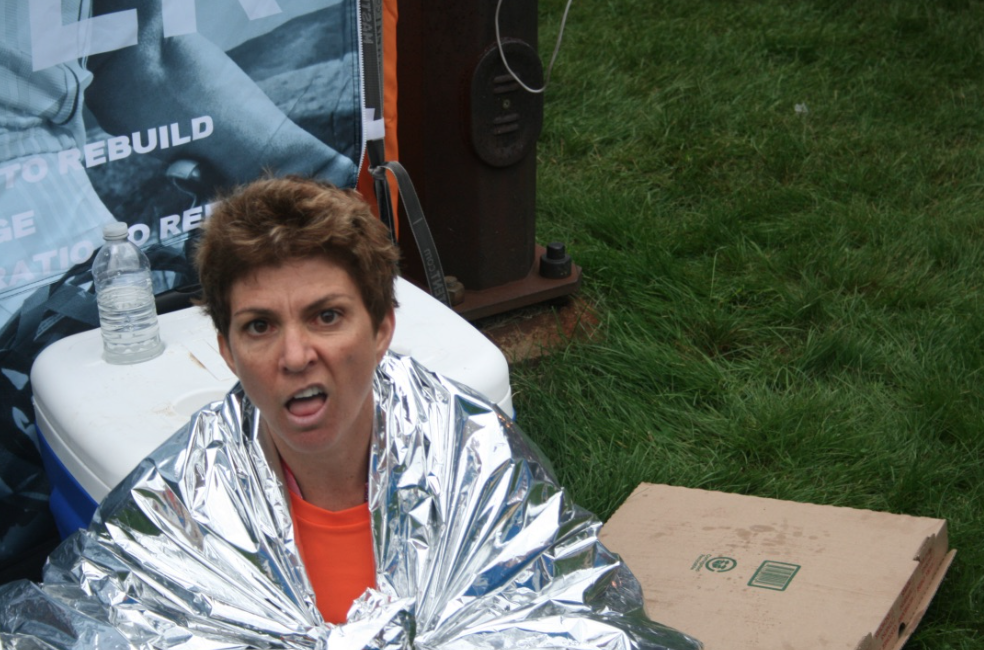Here’s Why & How To Fix It
If you’ve been training and racing endurance sports for long enough, you’ve likely experienced bloating or swelling. There are many causes of bloating, so figuring out the problem isn’t always black and white.
In this article, I’ll review the causes of bloating or swelling, different types of bloating/swelling, and what you can do to manage it should it happen in training or racing.

Why Am I Bloating?
Not all bloating is the same, and there are a variety of causes, including:
- too many carbohydrates with not enough fluids, which can slow gastric emptying,
- too many electrolytes, which can cause fluid retention,
- too much water relative to electrolytes (hyponatremia),
- Drinking water too quickly or in too big a serving
- dehydration,
- heat, which can cause reduced blood flow to the gut, leading to slower gastric emptying and digestion in your small intestine,
- Not enough practice with your specific fueling & hydration plan during training sessions.
- When racing at altitude, peripheral edema (swelling in arms, legs, and even face) can be associated with altitude sickness, so that’s another cause to be aware of.
To determine which of these causes might be at play, there are a series of questions we can ask.
Where is the bloating?
A symptom of hyponatremia is swollen fingers, whereas GI distress is typically confined to belly bloating, so the location of swelling is important.
Did you pee? What color?
Peeing eventually stops during hyponatremia, so if you are still peeing, that’s a good sign that it’s not hyponatremia and something else is causing the bloating. If the pee is dark in color, the cause is likely dehydration. (See image at the end of this article for understanding what the color of your urine is telling you.)
What did you consume in terms of calories, hydration, and electrolytes?
Knowing exactly what you took for calories, hydration, and electrolytes are important clues for figuring out what was the cause of bloating or swelling. Keep track of this in training!
What was the temperature?
This is another important piece of information for figuring out the cause of bloating or swelling. If it was a cooler race, and you took in the same amount of electrolytes you use in warmer conditions, bloating could have occurred because of too many electrolytes, causing fluid retention.
This is why it is important to practice your fueling/hydration plan for every workout, log the weather, and how you felt. This way, you and your coach have a record of what works and what doesn’t in a variety of different conditions.
How to manage bloating
So, what do you do if you experience swelling or bloating in a race or training? If you’re taking in plenty of electrolytes already, try taking in more plain water and see if it helps.
If you’re taking in mostly plain water and have swollen fingers or any other signs of hyponatremia, start taking electrolytes (either through a sports drink or salt tabs) immediately. Hyponatremia can be a life-threatening condition, so it is important to heed these warnings.
If you’re experiencing GI distress and have stomach bloating, cut back on calories and stick to water for a bit, try some de-fizzed Coke or chicken broth (if available).
And lastly, if you’re experiencing dehydration symptoms (bloating, thirst, nausea, dark urine or no urination, headache, cramps, increased heart rate, etc.), increase hydration, ideally a drink containing electrolytes, immediately.
With the right questions, you can figure out the cause of bloating or swelling to better prevent it in future training and races. Be diligent in your logging-in training, so you have a history to help you make good decisions on race day.
How to “read” your urination:

Keeping track of the color of your urination can be helpful when trying to diagnose what the issue could be.
If your urine is clear, you may be on the side of hyponatremia. Other symptoms of hyponatremia include nausea and vomiting, headache, confusion, loss of energy/fatigue, irritability, muscle weakness or cramps, and seizures. If left untreated, hyponatremia can lead to coma or death.
If your urine is dark yellow or darker, you are in dehydration territory. Symptoms of dehydration include increased HR with a subsequent decrease in pace or power output, as well as thirstiness, dry mouth, headache, dizziness, muscle cramps, and fatigue. If dehydration becomes severe, you may have pale skin, sunken eyes, a halt in urine production, convulsions, or a loss of consciousness.
It’s important to note that dehydration and hyponatremia have some similar symptoms. In the early stages, especially, nausea could be from either issue. So, you will need to assess whether the issue is low sodium (hyponatremia) or low fluid (dehydration).
If your urine is the color of Coca-Cola, very brown/dark, this could be a sign of rhabdomyolysis. This is a very serious condition. You should stop immediately and seek medical attention.
Bloating and swelling don’t have to derail your training or race day. If you’re ready to take the guesswork out of your fueling plan and feel confident from start to finish, our coaches at No Limits Endurance Coaching can help you create a personalized strategy that works for your unique needs, so you can focus on racing your best. Contact us for a free consultation.
